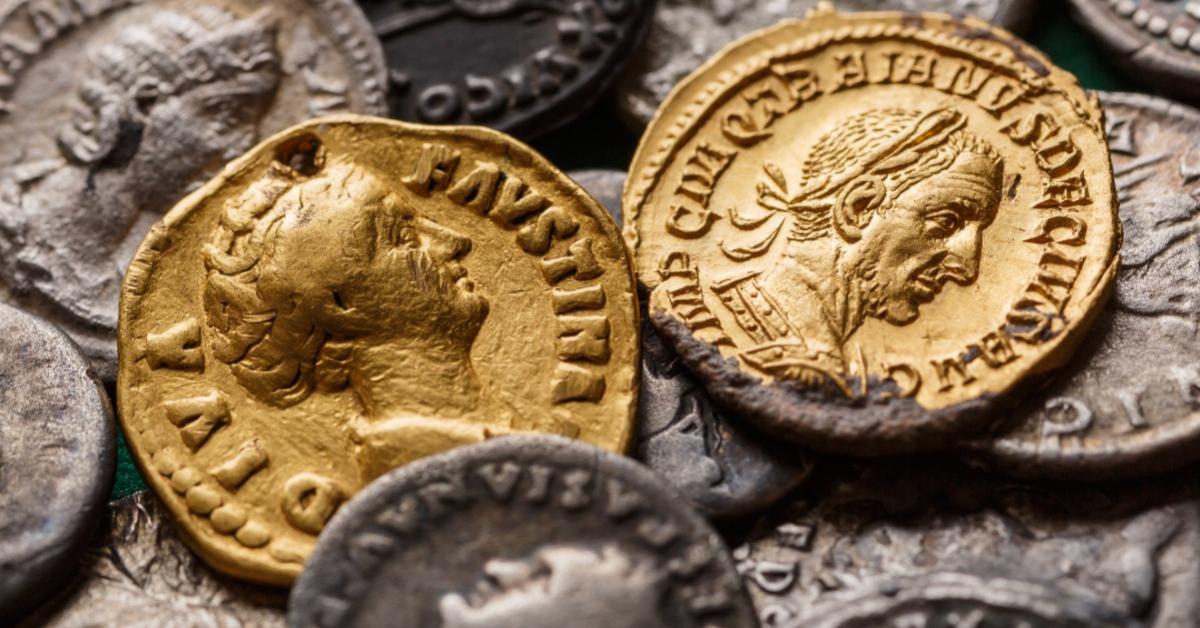
Since the reordering of Augustus, during the first two centuries of the empire, the Roman state manipulated the intrinsic value of the denarius argenteus, the main axis of the imperial monetary system, from the theoretical 3.892 grams and between 97.0 and 98.0 percent silver to 3.22 grams and 56.5 percent silver at the end of the second century AD.
The increase in military expenditure, social aid, payments to specific pressure groups, new public works, and various types of excesses greatly strained the indebtedness of the Roman state. Inflation was moderate in these first two centuries, averaging 0.7 percent per year, but excessive public spending seriously threatened to push overall prices and the stability of the imperial economic system out of control.
Caracalla, the “new Alexander,” continued and expanded the war policy of his father, Septimius Severus: he increased military pay to twenty-four hundred sesterces a year to undertake new campaigns against the Alamanni and Parthians, whom he bribed for peace, and to pay for everything, he again increased taxes and pursued a new expansive monetary policy. He devalued the three main coins: the aureus to 6.6 grams of gold, the denarius to 51.5 percent silver, and the sestertius to 24.8 grams of brass.
But his main invention was the creation of the argenteus antoninianus, weighing 1.5 denarii, or 5.11 grams, containing between 46 and 51 percent silver, but with the face value of two denarii, which became the standard coinage during the third century. At that time, inflation was still below 1 percent per annum and general prices were 2.67 times those of the Augustan period.
His successor, the prefect of the praetorium Opilius Macrinus, tried again to raise the official content of the denarius to 58.0 percent silver and to abandon the antoninianus project, but after his short-lived reign, Heliogabalus again returned to excessive public spending. The eccentric emperor-priest lowered the weight of the aureus to 6.35 grams of gold, the content of the denarius to 46.5 percent silver, and the weight of the sestertius to 22.5 grams of brass, as well as resuming the minting of the antoninianus with a content of 43.0 percent silver. The copper ace of Augustus began to disappear.
The fall from grace of the Severan dynasty marked the beginning of a period of profound political instability and economic crisis throughout the Roman Empire: up to twenty-six emperors reigned over the next fifty years, one emperor every two years on average. Gordian III, supported by the Praetorians, further reduced the weight of the golden coin to 4.85 grams, the antoninianus to 4.35 grams, and the sestertius to 20.5 grams to pay for his disastrous campaign against Sapor I of Persia.
But the empire would hit rock bottom in the middle of the century under Gallienus, who, in his fifteen-year reign, had to deal with more than ten different barbarian invasions and fifteen other usurpers of the imperial throne throughout the world. The devaluation of the coinage skyrocketed to levels never seen before, bringing the weight of the aureus down to 3.4 grams and the sestertius to 16.9 grams. However, the bulk of the devaluation went to the silver denominations: the antoninianus went from 3.5 grams and 36.0 percent silver in 253 to 2.4 grams and 2.4 percent silver in 268, while the denarius went from 41.0 percent silver to 6.0 percent silver. Denarii, sestertii, and dupondii virtually disappeared from circulation; as a result, the Roman population returned to barter and subsistence economy. Although general prices were only three times those of the Augustan period; this changed drastically shortly after.
Aurelian, the representative of the Unconquered Sun on earth, defeated the empires of Gaul and Palmyra and was thus named Restitutor Orbis. However, Aurelian intervened at the Moneta Caesaris, the headquarters of the Roman mint in the Imperial era, to stop a mass revolt of its workers, who demanded the restoration of confidence in the coins issued by the Roman state. Soon after, he launched his particular monetary reform: the aureus recovered the 6.6 grams of Caracalla’s time, and the argenteus aurelianianus, or large radiate, weighing 3.89 grams and containing 4–5 percent silver, was created to replace the depreciated antoninianus.
However, the Roman state requisitioned many goods needed to feed and clothe the troops, such as wheat, meat, wine, oil, textiles, and leather, while industry and commerce continued to deteriorate. These phenomena further aggravated the growing inflation: fewer and fewer goods were available on the market, and the mass of depreciated currency became larger and larger and circulated more and more.
At the end of the century, Diocletian tried to halt the disintegration of the Roman economy with “Keynesian” public policies that did not solve anything. Thus, the army was greatly expanded, adding thirty-five new legions to the forty-odd that existed before; a multitude of public works was carried out, including factories, mints, fortresses, roads, and bridges, as well as luxurious baths in Rome and his palace in Split; and, finally, a major program of expansion of the provincial bureaucracy was undertaken, so excessive that even Lactantius recognized that the number of public workers had begun to outnumber private taxpayers.
At the same time, he put in place a renewed monetary system more complex and articulated than that of his predecessors: the aureus, transformed into solidus, rose to 5.45 grams, with a renewed content of 99.26 percent gold; and the argenteus, with a weight of 3.38–3.40 grams and a surprisingly high silver content of between 92.00 and 98.00 percent, was created to replace the aurelianianus. Finally, three new copper and bronze coins were created: the 10.52-gram follis, laureatus maior, or nummus, composed of copper, lead, tin, and between 3.00 and 4.00 percent silver; the three-gram radiatus, with a composition of bronze and 0.10 percent silver; and the 1.27-gram bronze laureatus minor.
Diocletian carried out systematic confiscations of silver, war levies, new taxes, expropriations of metal at assessed prices and surcharges on land and property to ensure the practical application of this new monetary system application of censuses and annual budgets. As a result, the Roman economy became irreparably unbalanced: by Gresham‘s law, the argenteus was quickly thesaurised and disappeared from circulation. Inflation also turned into hyperinflation: if in 284, general annual inflation was 5 percent, by 294, general prices were fourteen times those of the Augustan era and inflation had risen to 10 percent; by 301, on the other hand, general prices were seventy times those of the Augustan era and inflation had soared to 35 percent.
By the end of the third century, the expansive monetary policies that Roman emperors had been continuously using to maintain their hold on power, to acquire political, military, and social support, had exhausted the Roman economic system throughout the empire.
To the Cantillon effect, which favored friends and colleagues of the emperor, generals, and allied senators, was now added Gresham’s law, which chronified the presence of coins of little intrinsic value on the market. The increasingly frequent confiscations, taxes, duties, and expropriations of gold and silver diminished the confidence of the Romans, who began to hide their property underground: we have 1724 and 1985 hoards from the 1st and 2nd centuries, respectively, a figure that doubled in the third century, with 3937 hoards. The rampant increase in the total money supply, together with the general decline in population and labor due to wars, pestilence, and other phenomena, generated annual hyperinflation of 35 percent at the end of the third and beginning of the fourth century: the Roman economy was no longer able to absorb all the newly created money and the prices of all goods were profoundly altered.
The rejection of low-quality currency led to the rise of barter, which reduced the possibilities of long-distance trade and economies of scale, condemning the various inhabitants of the empire to local and subsistence production. The large specialized industrial and agricultural producers dwindled, as did the various guilds of craftsmen and merchants in the different cities of the Mediterranean, forcing the emperors to create public companies to supply their armies, making the system more inefficient and costly.
The resulting economic crisis exacerbated state tax collection: the emperors were increasingly forced to pay the army and to collect tribute largely in kind, through indictiones extraordinariae, which became the most important form of revenue during the second half of the third century. The result was widespread poverty and the destruction of much of the Roman economic fabric.



